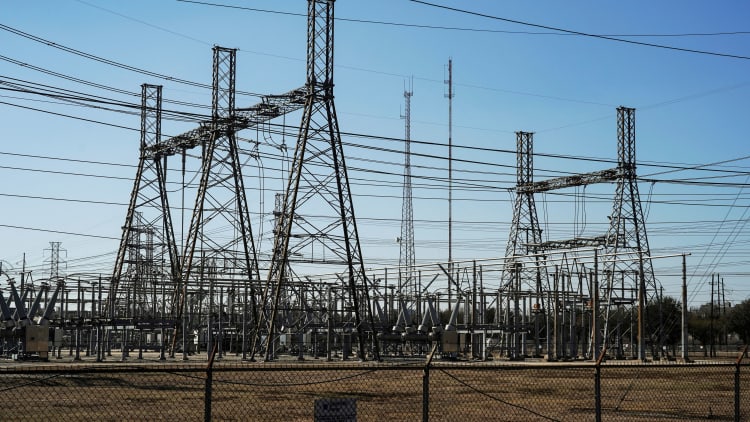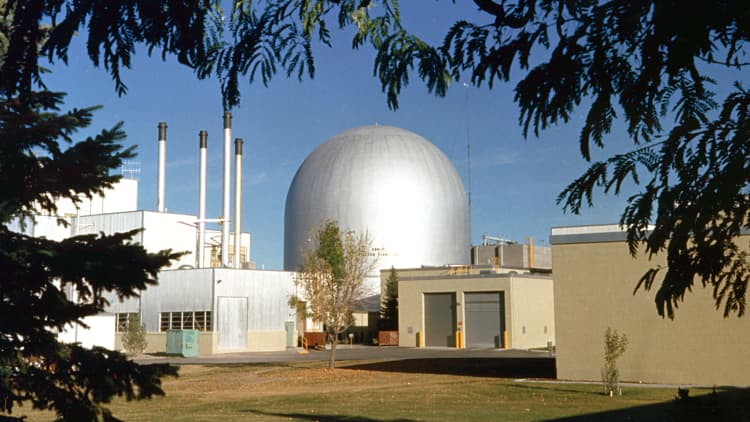Wind turbines and power transmission lines at a wind farm near Highway 12 in Rio Vista, California, Tuesday, March 30, 2021.
David Paul Morris | Bloomberg | Getty Images
The U.S. electricity grid is being pushed to the brink, with parts of California, the Midwest and South Central United States at “highest risk” for power shortages, according to the nonprofit organization Grid.
According to the 54th annual assessment conducted by the North American Electric Reliability Corporation, the “high risk” regions marked in red on the map can see faults under “normal high conditions”.
The reasons for the weaknesses are different.
In the Midwest states and Ontario, more power generation is being retired than is being added online, NERC’s Mark Olsen told reporters Thursday. Planned power shortages have been seen in that region since 2018, Olson said.
In California, the risk is due to a “changing mix of resources” and “volatility of demand,” Olson said. This means there is a lot of renewable energy in the state, and its generation is not coordinated with when people need it most. NERC predicts that by 2024 peak summer demand could fall below supply for 10 hours.
Most of the Midwest and the rest of the western United States are at “high risk” (yellow on the map), which means that outages are likely to occur under extreme conditions, such as running air conditioners during extreme weather or hot weather. In New England, when people use generators that rely on natural gas, a higher risk comes in the winter.
“Natural gas capacity may not be sufficient for generators, there are risks to reserve fuels, use of stored liquid fuels, and maintaining adequate fuel reserves in long-term events,” Olsen said.
The Southwest could also suffer if demand is high and wind generation is low in the region.

‘Strange Times’
“We’re living in a unique time for the electricity industry,” John Mura, director of reliability assessment at NERC, said Thursday.
Increasing awareness of climate change is pushing utilities to move away from fossil fuel-based energy sources that generate carbon emissions. Renewables like wind and solar do not contribute to climate change, but they have periods of time (when the sky is dark or the wind is calm) when they are not producing any power.
Unlike fossil fuels, renewables do not map to where they are needed, they can be transported and burned in the area where they are consumed. That means more transmission lines are needed, and building them could take seven to 15 years, Mora said.
Another area of note, according to NERC, is the increasing energy demand of cryptocurrency mining and the need to plan the use of energy there.
Then there is the weather. It’s difficult to link specific weather events to climate change, but it’s generally true that the warmer world is getting wetter, say NASA climate scientists.
“Year after year, we’ve seen extreme weather leading to reliability impacts. And so looking at what’s happened over the last several years, it’s clear that the bulk power system is more weather-driven than ever before,” he told reporters on a media call.
These factors are putting additional pressure on the grid, and NERC representatives urge grid operators to be conservative in their planning.
“Managing the pace of our generation’s retirement and changing wealth mix is absolutely essential to ensure we have enough energy and essential services,” Mora said on the call. “We need to work with the whole ecosystem to make sure we’re managing this base and not prematurely retiring a generation – this is across the board and especially in places on the edge.”
For the annual long-term electricity security assessment, NERC looks at the next decade, but the energy and capacity risk assessment will be issued for the next five years, from 2023 to 2027. The next five years should be significant, according to NERC.
The Federal Energy Regulatory Commission chartered NERC in 2006 to measure and enforce security standards for the energy grid in the United States. NERC is regulated by FERC, which is the federal government agency responsible for regulating interstate electricity transmission.

.
[ad_2]
